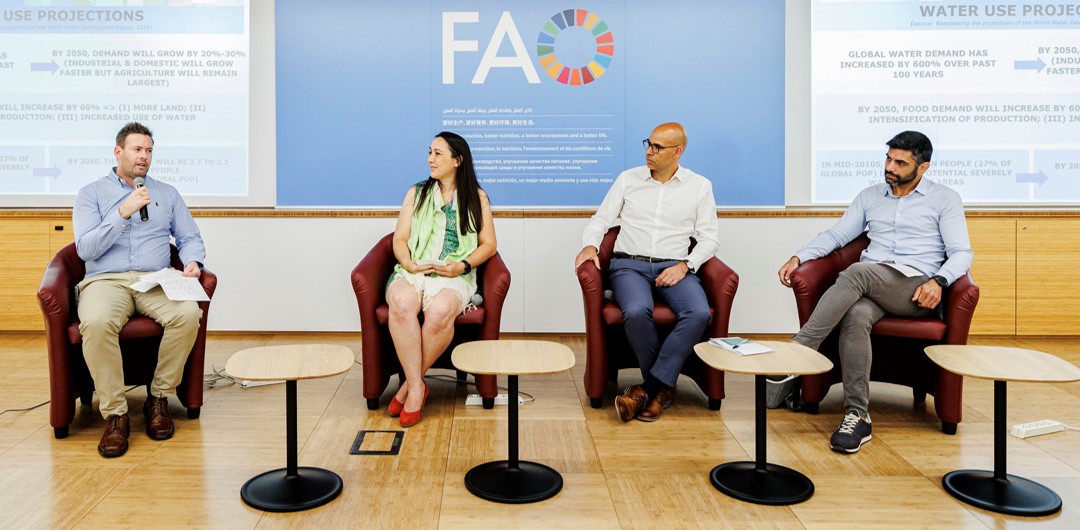Keeping water flowing: A look at innovative digital solutions for better agricultural water use

Without water there is no food. Yet rising temperatures and unpredictable weather patterns – frequent and intense periods of drought, flooding, fires – are threatening water resources across the globe.
Innovative digital solutions, like geospatial data, remote sensing and IOT (internet of things) provide real-time monitoring and data analysis for better decision-making around agricultural water use.
Panelists explored some of those solutions during one session at the FAO Investment Centre’s Investment Days – organized this year around investing in food security and climate resilience.
FAO Senior Economist Carlo Bravi, who moderated the session, pointed to how water demand, of which 70 percent comes from agriculture, is set to see a major increase by 2050.
In addition to powerful drivers like population growth, rapid urbanization, climate change and biodiversity loss affecting water quality and supply, “our existing dam infrastructure was not designed for the current types of rainfall and weather patterns,” he said.
Eye in the sky
The session looked at both “eye in the sky” digital technologies and “boots on the ground” solutions for more sustainable agricultural water use.
One example is the FAO-developed WaPOR – Water Productivity through Open access of Remotely sensed derived data portal.
With near real-time satellite data, the tool can help countries monitor agricultural water productivity and identify and reduce water productivity gaps. It can also calculate key variables like actual water consumption or be used to estimate irrigation water application and economic irrigation water productivity.
The correct application of WaPOR, when combined with economic data, can lead to better policy and investment decisions, said FAO Economist Luis Dias Pereira, like on water quotas and tariffs or incentives for changing cropping patterns.
Annemarie Klaasse, Business Line Leader for Water and Environment at eLEAF, which leads the consortium providing open-access satellite data in the WaPOR database, stressed that satellite data is not replacing existing on-the-ground data but rather filling spatial and temporal gaps.
“The data is accurate, repeatable, timely but also scalable,” she said, “and it is available globally.”
“I would like to see satellite data become a best practice source of information for strategic investment planning and design,” she added. “You can analyze the impact of an investment on nature but also the impact of nature on an investment.”
Boots on the ground
xFarm, an example of a boots on the ground Italian scale-up company, provides solutions via a digital platform. Clients range from small-scale farmers to larger agrifood companies.
According to Simone di Domenico, Agronomic R&D Manager for xFarm, the platform is equipped with a basic level of free functions plus a raft of premium modules. Farmers can buy packages adapted to their specific needs, helping them to improve efficiency and save time and money.
For example, the irrigation module uses information collected from weather stations and sensors, including on soil moisture, to provide targeted advice on when and how long to irrigate crops as well as how much water to use, down to the millimetre.
Using that irrigation module, xFarm carried out a pilot coffee intervention in Brazil where they were able to save 30 percent of water over one growing season while maintaining the same yield.
Despite its increasing accuracy and higher resolution, satellite imagery still has gaps. Ground data from sensors can confirm what is observed through satellite imagery, enabling more reliable farm level advisory, even in areas where sensors are not present.
Combining satellite data with on-the-ground data “is the way forward,” di Domenico said, adding that the company is also working to develop sensorless technologies to reach more farmers.
Water-food nexus
The discussions raised questions around issues like water pricing, how to bring these technologies to scale and make them accessible, especially to small-scale farmers and small and medium enterprises, and the challenges of internet connectivity.
The discussions also touched on the financing of such digital solutions, including through instruments like green bonds or ecosystem services payments.
Robert C. Brears, founder of Our Future Water in New Zealand, who spoke of the circular economy of water – reduce, reuse, recover, restore, recycle – said he was struck by the parallels between the agrifood and water sectors.
“Both sectors are very fragmented, with smallholder users and large-holder users, both face a lack of investment and funding, especially amid government budgetary constraints, and there is a demand for the private sector to do much more,” he said.
He encouraged everyone to focus more on the water-food nexus and to “keep water in the conversation.”
